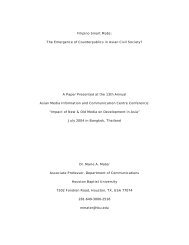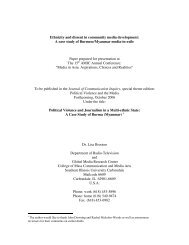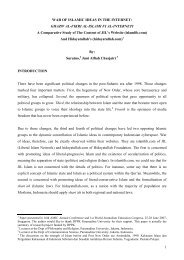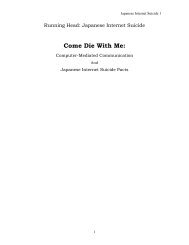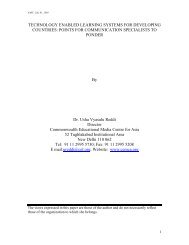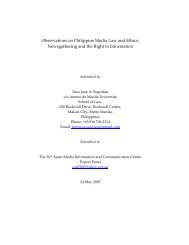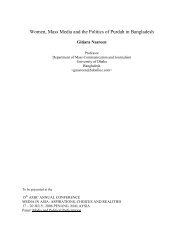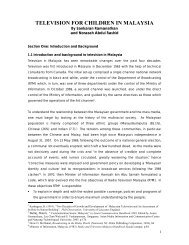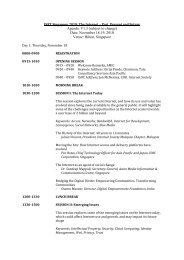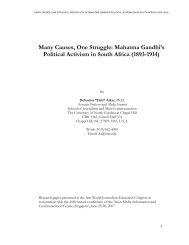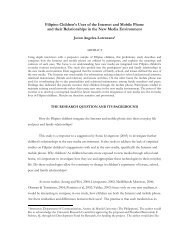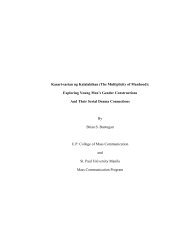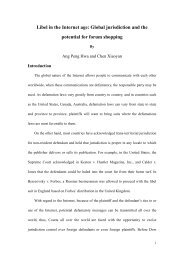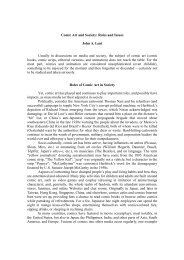PHILIPPINE ONLINE JOURNALISM: - AMIC
PHILIPPINE ONLINE JOURNALISM: - AMIC
PHILIPPINE ONLINE JOURNALISM: - AMIC
Create successful ePaper yourself
Turn your PDF publications into a flip-book with our unique Google optimized e-Paper software.
<strong>PHILIPPINE</strong> <strong>ONLINE</strong> <strong>JOURNALISM</strong>:<br />
PROMISE AND PERILS<br />
By Manuelita Dela Torre Contreras and Crispin C. Maslog*<br />
Journalism is going through crucial changes – changes that may be considered<br />
most fundamental to journalism since the advent of the penny press. Worldwide access to<br />
information, ubiquitous news, real-time reporting, multimedia content, and interactivity<br />
are just some of the manifestations of this change in the journalism landscape (Pavlik,<br />
2001).<br />
Pavlik is referring to no less than the rise of online journalism. Since the creation<br />
of the first graphical browser for the World Wide Web in 1993, thousands of newspapers<br />
have made their way to the online realm. In the United States, where online journalism<br />
traces its early development, there were more than 1000 online newspapers as early as<br />
1996. By 1999, the number of these newspapers soared to 4900 (Pavlik, 1999; Sproull,<br />
2000; Hall, 2001).<br />
In Asia, there were 11 reported newspapers on the Web as early as 1995; among<br />
them were China’s The China Daily, Malaysia’s Utusan Malaysia, Indonesia’s Kompas,<br />
and Japan’s Asahi Shimbun (Carlson, 2005). Today, most, if not all, Asian countries can<br />
be considered practicing online journalism. In Southeast Asia, for instance, a computer<br />
check revealed that each country has at least one online newspaper.<br />
________________________________________________________________________<br />
* Manuelita Dela Torre Contreras is a master’s degree graduate, and Dr. Maslog<br />
is a former visiting professor of the School of Communication, Nanyang Technological<br />
University, Singapore,<br />
P10 - Crispin C. Maslog.doc<br />
Received on 12/04/2006
In the Philippines, online journalism started with the arrival of The Manila Times,<br />
a national daily newspaper, on the Web in 1995, the year after the country acquired a<br />
permanent public Internet connection (ITU, 2002). In the same year, Business World<br />
Online was launched on the Web, making its mark as the first Philippine online business<br />
newspaper.<br />
Various problems beset the early days of Philippine online journalism; among<br />
these were fundamental problems such as limited or lack of infrastructure necessary to<br />
wire the country or to get a basic Internet connection. The Philippines dawdles in<br />
information and communication technology (ICT). In 2004-2005 for instance, it scored<br />
negatively (-0.43) and ranked 67th among 104 countries in the Networked Readiness<br />
Index (NRI), a measure of a country’s readiness to participate in and gain from the<br />
developments of ICT (World Economic Forum, 2005).<br />
This limited ICT directly and indirectly affects the development and use of online<br />
journalism. For one, lack of technology means lack of access to hardware necessary to<br />
access the Internet and the online medium. Likewise, it hinders the people from acquiring<br />
ICT literacy, such as the literacy to use computer applications or the computer hardware<br />
itself. These and other factors are crucial to the tapping and use of online journalism, as<br />
lack of them means lack of or low access to the online medium.<br />
Nonetheless, the online medium is now being utilized in the country for purposes<br />
such as information and communication. Online journalism, for instance, is now being<br />
used for social advocacy. A number of non-government and non-profit groups have<br />
started using online journalism to advocate for their cause by, for example, providing<br />
information on certain issues that are not commonly covered by the mainstream media.<br />
P10 - Crispin C. Maslog.doc<br />
Received on 12/04/2006
Also, provincial online news publications help fill the information gap between their<br />
community and their community members living or working abroad or elsewhere in the<br />
country. Likewise, national online news publications have become prime sources of news<br />
and information of Filipinos abroad. They provide a fast and convenient way of getting<br />
news from home. There are approximately eight million Filipinos working abroad (The<br />
Manila Times, 2004). In the first half of 2005 alone, for instance, 502,772 overseas<br />
Filipino workers (OFWs) were deployed to work abroad (INQ7.net, 2005). They work in<br />
various continents and regions of the world, such as Asia, Europe, North and South<br />
Americas, Australia, and Africa (Philippine National Statistics Office, 2003). This<br />
diaspora has created a greater need for news from the Philippines, a need that cannot be<br />
readily fulfilled by the traditional media because of lack of access to them.<br />
Online Journalism: Definition and Concepts<br />
Before zooming in on the case of Philippine online journalism, it is important to<br />
first know and understand the definition and concepts of online journalism. Online<br />
journalism is loosely defined as journalism on the Web, which is considered a news<br />
medium in the sense that it allows the posting of news and information (Stovall 2004).<br />
This definition, however, misses important facets that make this journalism distinct from<br />
traditional journalism. Ward (2002) has identified some points that correct<br />
misconceptions about this medium. He proposes that what basically makes online<br />
journalism different is the fact that it is multifaceted and user-centered. Unlike traditional<br />
journalism, which puts audiences at the receiving end of the mass communication<br />
process, online journalism places users in the forefront of this process.<br />
P10 - Crispin C. Maslog.doc<br />
Received on 12/04/2006
In terms of content, online journalism requires that all the elements of the online<br />
medium support the presentation of online content. Although the other components and<br />
features (e.g. interactivity) of this medium are indispensable to its full utilization, content<br />
should remain at the core of online journalism.<br />
Ward further asserts that the basic precepts and processes of journalism should be<br />
linked to all the steps of online news gathering, writing, and reporting. Although online<br />
journalism is considered new and different, the core values and principles of traditional<br />
journalism should remain at its base. Journalistic principles and processes have to be<br />
integrated in all the stages of online news production and delivery.<br />
This paper is based on a study conducted by the authors on the history and<br />
development of online journalism in the Philippines. The study aimed to trace, describe,<br />
and analyze the development of the Philippines’ online journalism, using both content<br />
analysis and interview for its data collection. Document research was also done to trace<br />
the history of this new medium in the country.<br />
HISTORICAL DEVELOPMENT<br />
Online journalism is relatively new in the Philippines. It was only in 1994 that the<br />
country acquired a permanent public Internet connection, although some businesses<br />
started setting up their own connections in the early 1990s. Approximately 90 percent of<br />
the Internet traffic goes abroad, mostly to the U.S., according to an International<br />
Telecommunication Union (ITU) case study. But local traffic continues to grow as<br />
Internet facilities and services continue to improve (ITU, 2002).<br />
P10 - Crispin C. Maslog.doc<br />
Received on 12/04/2006
In September 1995, The Manila Times, a national daily newspaper, went online,<br />
paving the way for other news publications. In its initial and testing phase online, it was<br />
serving only 100 local subscribers before eventually going international (Pabico, 1999).<br />
The following month, Business World Online was launched on the Web, establishing its<br />
niche as the first Philippine business paper to venture online. However, unlike The<br />
Manila Times, which utilized a windows-based application that allowed easy navigation,<br />
it was using DOS, a cumbrous system.<br />
During its early years in the Philippines, online news publishing was not exactly<br />
seen as something very economically viable to displace print newspapers from their<br />
throne. Priority was still given to the print medium; putting up an online edition was one<br />
of those done on the side. Business World Online, for example, was put up with the intent<br />
of attracting online readers to subscribe to the print newspaper. If readers signed up for<br />
subscription, they were given access to the online version for an additional monthly fee<br />
(Pabico, 1999).<br />
The early days of Philippine online journalism were plagued with various<br />
problems and limitations; chief of these was the limited or lack of necessary<br />
infrastructures. For example, the fixed telephone system was ineffectual as there were a<br />
limited number of telephone lines in the National Capital Region (NCR), and much more<br />
so in the provinces. This impeded the early and speedy arrival of newspapers and other<br />
news publications on the Web. It also stymied early access to the online medium by<br />
Filipino users.<br />
Provincial news publications came later to the online scene. Their development<br />
can be traced to the Globicom (Globalization of Island Community Newspapers) project<br />
P10 - Crispin C. Maslog.doc<br />
Received on 12/04/2006
initiated in 1999, although some provincial papers (e.g. The Freeman Online, The Bohol<br />
Times Online, Sun.Star Network Online, etc.) were already online before this project was<br />
even conceptualized. Globicom aimed at providing a portal where provincial newspapers<br />
could post their news stories and other articles for online access and consumption. It was<br />
also meant to connect Philippine Press Institute (PPI) members online, to promote<br />
interaction among them, and to raise the country’s community press to a higher level<br />
online. The project was an initiative of the PPI, an organization of Philippine newspapers,<br />
in partnership with Business World Online and funded by United Nations Educational,<br />
Scientific, and Cultural Organization (UNESCO).<br />
Globicom came up with templates for community newspapers that participated in<br />
the project and organized seminars for their publishers and editors. A number of<br />
newspapers were able to go online and sustain their presence on the Web even after<br />
Globicom’s termination. However, according to PPI’s former executive director Ermin<br />
Garcia, Jr., the project was barely successful mainly because of lack of funding and<br />
support from Internet service providers. Also, it should be noted that several community<br />
or provincial papers went online without Globicom’s assistance.<br />
One of the crucial points in the history of Philippine online journalism was in<br />
1998. This year saw the rise of news publications going online, as well as of the<br />
perceived profitability of the online medium. By this time, more and more companies<br />
started to see the advertising potentials of this medium, with the 1997 economic crisis<br />
helping boost online advertising as a cheaper alternative to mainstream media advertising<br />
(Datinguinoo, 1999).<br />
P10 - Crispin C. Maslog.doc<br />
Received on 12/04/2006
Now, the Philippines has more than 30 known online news publications, although<br />
some had been inactive for a period of time. This figure includes only those that provide<br />
news as their main service, ranging from online versions of print newspapers to online<br />
daily newspapers, online weekly newspapers, online news magazines, and online<br />
newspaper-television joint ventures. Many of them are based in Metro Manila; the others<br />
are in the provinces. INQ7.net, a joint venture of a television network and a major<br />
national daily, claims the biggest readership.<br />
The low Internet penetration and access and the unequal distribution of Internet<br />
connection in the country constrain online news publications from reaching more<br />
audiences. However, the online medium continues to bring opportunities for online<br />
publication. The number of online news websites has increased, although some had<br />
closed down. All the major daily newspapers in the country have their online versions.<br />
Some non-profit groups (e.g. Bulatlat.com) have started taking advantage of the online<br />
opportunity to put their causes forward by, for instance, providing news, discussion, and<br />
analysis not commonly found in the mainstream media.<br />
Understandably, Philippine online news publications experience the highest<br />
number of visits, mostly by Filipinos abroad as well as foreign observers, during crucial<br />
events and periods. For example, during the impeachment trial of former president Joseph<br />
Estrada in December 2000, abs-cbnNEWS.com recorded an average of 1.5 million visits<br />
per day, reaching five million during the peak of Estrada’s overthrow from power. On<br />
ordinary days, it gets around 300,000 hits a day (Torres, 2004).<br />
Philippine Online Journalism: Early Promise<br />
P10 - Crispin C. Maslog.doc<br />
Received on 12/04/2006
Overall, Philippine online journalism is still in its infancy. Although some<br />
publications went online as early as 1995, most of them can be considered young, while<br />
the others are relatively new. Hence, experimentation, adjustment, and alteration are<br />
evident among them. Some did not go further than the experimentation stage and had<br />
folded, while the others keep up and continue to make some progress. Although this<br />
progress is slow, the country’s online journalism is likely to advance once the<br />
fundamental shortcomings and pressing problems are addressed and resolved.<br />
Online Access<br />
The Internet has low penetration in the Philippines mainly due to lack of<br />
sufficient ICT infrastructure and the high cost of Internet subscription and the necessary<br />
hardware (only 2.7 percent of households having personal computers as of 2000,<br />
according to ITU). The National Telecommunications Commission (NTC) reported<br />
1,852,333 Internet subscribers in 2003. In 1999, the Internet penetration was recorded at<br />
0.62 percent, and 2.46 percent or approximately 2.0 million users at the end of 2000<br />
(ITU, 2002). In 2003, there were 3.5 million recorded Internet users in the country, while<br />
in 2004, the number jumped to 11.8 million, both at residential and commercial levels<br />
(ITU, 2004; IDC, 2005).<br />
Most of those with Internet access are in the NCR and those abroad where access<br />
is better and easier. Many Philippine rural areas do not have Internet access because of<br />
lack of fixed telephone line, which is necessary for dial-up connection, the most common<br />
and cheapest form of Internet connection in the country. Fixed telephone lines are<br />
concentrated in the NCR, which has 43 percent of the 6.5 million fixed lines in the<br />
P10 - Crispin C. Maslog.doc<br />
Received on 12/04/2006
country (NTC 2003 Status Report, 2004). What makes the situation more difficult is the<br />
fact that some rural, far-flung communities do not have electricity or regular supply of<br />
electricity. According to a National Statistical Coordination Board (NSCB) data, 2.8<br />
million Filipino families living below the poverty level do not have electricity (The<br />
Manila Times, 2003).<br />
Insufficient and inefficient ICT infrastructure leads to inequality in access and use<br />
of the Internet. This inevitably leads to what is called ‘digital divide’ within the country<br />
between the areas with sufficient infrastructure (notably the NCR) and those without or<br />
with limited infrastructure (mostly far-flung provinces and communities). It can be<br />
deduced here that there is also unequal or uneven growth of ICT literacy between these<br />
geographic areas. These factors consequently contribute to the uneven access to and use<br />
of the online medium.<br />
Kinds of Philippine Online News Publications<br />
Most Philippine news websites are online newspapers, many of them Web<br />
editions of print dailies, weeklies, or semi-weeklies. The others are online news<br />
magazines and television-newspaper joint ventures. These publications come out in<br />
various frequencies, most of them daily. The rest come out less frequently, such as<br />
weekly, semi-weekly, and bi-monthly. The presence of these less frequent publications<br />
does not seem apt on the Web because of the nature of the medium itself. As they are<br />
updated less often, their content seems too old to be considered news.<br />
More than half of the identified publications, both provincial and national, are<br />
published in English. Even those using both local language and English dominantly had<br />
P10 - Crispin C. Maslog.doc<br />
Received on 12/04/2006
more articles written in English. Among the few news websites published in local<br />
language, only one is province-based; the rest are all Metro Manila-based.<br />
With several provincial news websites folding up in the last few months and<br />
years, by the time the study was being conducted, there were more Metro Manila-based<br />
than province-based online publications. Their ratio shows a big discrepancy, considering<br />
the number of provinces in the country and their geographic size and coverage compared<br />
to that of Metro Manila. This gap may still widen if small community news websites<br />
continue to close down mainly because of financial constraints.<br />
Table 1.0 Online news publications based on scope of coverage or audience reach<br />
National online news publications<br />
Online newspapers:<br />
Abante Online<br />
Abante Tonite Interactive<br />
Balita<br />
Business World Online<br />
Chinese Commercial News<br />
Kabayan News Online<br />
Malaya<br />
Manila Standard<br />
Pinoy Weekly Online<br />
PJI Journal Group<br />
Philstar.com<br />
Tempo<br />
The Daily Tribune<br />
The Manila Bulletin Online<br />
The Manila Times<br />
TODAY<br />
Online television-newspaper publications:<br />
abs-cbnNEWS.com<br />
INQ7.net<br />
Online news magazines:<br />
Bulatlat.com<br />
Cyberdyaryo<br />
P10 - Crispin C. Maslog.doc<br />
Received on 12/04/2006<br />
Provincial online news publications<br />
Online newspapers:<br />
Bandillo ng Palawan<br />
Daily Zamboanga Times<br />
KAIBA News and Features<br />
Mindanao Times News Online<br />
MindaNews<br />
Sun.Star Network Online<br />
Sunday Punch Online<br />
TarlacNews.net<br />
The Bohol Chronicle<br />
The Bohol Times Online<br />
The Freeman Online<br />
The Ilocos Times Online<br />
The Mindanao Daily Mirror<br />
The Palawan Times<br />
The Visayan Daily Star<br />
Tribune Eastern Visayas Online News<br />
Online news magazine:<br />
Nueva Ecija Journal
(Sources: Philippine Journalism Review, http://www.pinoypress.net, http://www.worldnewspapers.com/philippines.html,<br />
http://www.yehey.com/search/categories.aspx?c=903)<br />
Content<br />
Content-wise, most Philippine online news publications are still stuck in the basic<br />
level of online content development. More than half of the publications use shoveled<br />
content or content that is taken from a traditional medium, mostly newspapers. These<br />
publications are all online versions of print publications, which serve as their sole source<br />
of content. Most of those with print counterparts simply shovel content from their print<br />
edition, adding some refurbishings and features such as links to other articles or sections,<br />
a search engine, and feedback mechanisms for readers. Publications without print<br />
counterparts mostly have limited content; recycling or re-using of old articles is common<br />
among them.<br />
Five of the identified publications run a combination of both original and<br />
shoveled contents. They all have traditional media counterparts (newspaper or television<br />
network), and are regularly updated for breaking news. These publications, however,<br />
vary in their amount or quantity of original content and shoveled content. INQ7.net, for<br />
instance, has far more original content than Philstar.com, as it runs original or web-only<br />
sections besides its breaking news. On the other hand, Philstar.com carries only breaking<br />
news for its original content. Five of the news websites run original content because they<br />
are solely web publications.<br />
Two news websites can be considered in an advance stage in terms of content.<br />
They are characterized by their original articles and more interactive and sophisticated<br />
features appended to their content to make reading and navigation easier. Other features<br />
P10 - Crispin C. Maslog.doc<br />
Received on 12/04/2006
are also present, such as sending of articles through email, instant sending of comments<br />
on articles, text-only option, and article index. INQ7.net, for instance, can be considered<br />
in an advance stage. Although it posts articles from its print counterpart, it runs original<br />
content and features several sections targeted at specific niches of audiences (e.g. Global<br />
Nation for Filipinos abroad, Roadtrip for travelers, YOU for young audiences, etc.).<br />
Besides, it has features, capabilities, and services comparable to those of major<br />
international news content providers.<br />
Sections and Articles<br />
Most of the news websites carry the usual newspaper sections, but the number of<br />
these sections varies between the national-based and the province-based publications.<br />
The national websites have more variety and choices of sections, ranging from news<br />
sections such as breaking, national, Metro, provincial, and other news to more specific<br />
sections such as business, features, and lifestyle. However, the presence or number of<br />
these sections is never uniform among the publications. Even among the major news<br />
websites based in Metro Manila, their number of sections varies; some have more, some<br />
less. The commonly missing sections among the provincial publications include breaking<br />
news, business, international news, lifestyle, and audio-visual.<br />
Stories are more on national and local news. Some national publications carry<br />
international news from wires, but these are limited in number. Some do not normally run<br />
international news, unless there are events of national or international concern. Province-<br />
based publications do not commonly run international news. Readers’ interest is more in<br />
local news. For instance, community members based overseas would prefer to read more<br />
about their community, municipality, or province than about other countries.<br />
P10 - Crispin C. Maslog.doc<br />
Received on 12/04/2006
The publications have various numbers of articles, although most of the national-<br />
based with print editions carry more than 50. On the other hand, most province-based<br />
with print counterparts have an average of 21 to 30 articles. Those with the least number<br />
of stories are a weekly publication and a bi-monthly journal, both province-based.<br />
Understandably, provincial publications have less content as their ambit of coverage and<br />
audience reach are relatively small. Those with print counterparts have an obvious edge<br />
over those solely web-based in terms of content. They have a regular source of articles<br />
besides, in the case of a few big publications, their original content.<br />
The frequency of content updating of most of the websites is tantamount to the<br />
frequency of their publication. That is, if the publication is being published weekly,<br />
normally it is also being updated weekly. Only a few publications (INQ7.net,<br />
Philstar.com, Sun.Star Network Online, Balita.org, and abs-cbnNEWs.com) update their<br />
content (mainly their major news articles) constantly. These are the publications with<br />
breaking news, and once again, they are mostly national-based. Many of the publications<br />
are updated daily or regularly, as most of them are online daily newspapers. The least<br />
updated is the one with the least frequency of publication – Nueva Ecija Journal, which<br />
is a bi-monthly online news magazine.<br />
Content Availability<br />
In terms of content availability, majority of the publications have accessible<br />
archives, most of them free of charge. Only one, Business World Online, has paid access<br />
to all its archive. INQ7.net also practices paid access, but its last seven days of issues can<br />
be accessed for free. Most of the accessible archives carry past issues dating back up to at<br />
P10 - Crispin C. Maslog.doc<br />
Received on 12/04/2006
least one year. The longest archive duration is 11 years (Business World Online), and the<br />
shortest is five days (The Daily Tribune). The average or most common duration is one to<br />
two years.<br />
The most common type of archive searching is by date, as most of the past issues<br />
of the online publications are compiled based on their date of issue, commonly by month.<br />
Only a few archives can be accessed or searched using more than one option, such as<br />
both by date and subject or key words. The other types of searching are by author and<br />
section, although very few publications use these.<br />
It is interesting to note that of the seven publications without accessible archive,<br />
five of them are Metro Manila-based, which include two of the considered leading news<br />
websites in the country. (See table below.)<br />
Alternative means of news delivery such as through SMS and news mail are<br />
available, but only to a limited extent. Only a few big publications offer SMS news<br />
service.<br />
Online News Publications<br />
Abante Online<br />
Abante Tonite Interactive<br />
abs-cbnNEWS.com<br />
Balita.org<br />
Bandillo ng Palawan<br />
Bulatlat.com<br />
Business World Online<br />
Cyberdyaryo<br />
INQ7.net<br />
Malaya<br />
Manila Standard<br />
P10 - Crispin C. Maslog.doc<br />
Received on 12/04/2006<br />
Table 2.0 Online news publications’ archive availability<br />
Archive<br />
Accessible<br />
�<br />
�<br />
�<br />
�<br />
�<br />
�<br />
�<br />
�<br />
�<br />
Archive not<br />
Accessible<br />
�<br />
�<br />
�<br />
With<br />
Charge<br />
�<br />
Without<br />
Charge<br />
�<br />
�<br />
�<br />
�<br />
�<br />
�<br />
�<br />
�
Mindanao Times News<br />
Online<br />
MindaNews<br />
Nueva Ecija Journal<br />
Philstar.com<br />
Pinoy Weekly Online<br />
PJI Journal Group<br />
Sun.Star Network Online<br />
Sunday Punch Online<br />
TarlacNews.net<br />
Tempo<br />
The Bohol Chronicle<br />
The Bohol Times Online<br />
The Daily Tribune<br />
The Freeman Online<br />
The Ilocos Times Online<br />
The Manila Bulletin Online<br />
The Manila Times<br />
The Mindanao Daily<br />
Mirror<br />
The Visayan Daily Star<br />
Multimediality<br />
�<br />
�<br />
�<br />
�<br />
�<br />
�<br />
�<br />
�<br />
�<br />
�<br />
�<br />
�<br />
�<br />
�<br />
The presence of multimedia features or the multimediality of the subject<br />
publications is at a modest stage. Download options and audio and audio-video services,<br />
for instance, are a rarity. Similarly, useful links to related information in major articles<br />
are largely absent. The other options include download of the front page of a few<br />
publications’ print counterparts and some data.<br />
In terms of multimedia services or features, overall the subject publications<br />
cannot be considered in an advance stage, as most of them have only basic features such<br />
as simple images. The use of graphics is also low, as most of the publications have simple<br />
and basic design and layout.<br />
Content Services<br />
P10 - Crispin C. Maslog.doc<br />
Received on 12/04/2006<br />
�<br />
�<br />
�<br />
�<br />
�<br />
�<br />
�<br />
�<br />
�<br />
�<br />
�<br />
�<br />
�<br />
�<br />
�<br />
�<br />
�<br />
�
Among the services available in the subject publications are email newsletter,<br />
news through SMS (short message service) or mobile phone, results of licensure<br />
examinations (e.g. medical, engineering, and bar examinations), and “about us” section (a<br />
section that provides information about the publication). Only a little more than half of<br />
the news websites carry information about the publications themselves or the<br />
organizations behind them. The study underscored the value of such information as it<br />
allows the readers to know the people or the organization behind the publication and<br />
helps them gauge the credibility of the news website. It is particularly useful to new<br />
users.<br />
Only a few national publications, most of them big and leading media<br />
organizations, offer SMS news service. Those that post examination results are all<br />
national publications; the same with news mail service. Other services available include<br />
online community bulletin and currency converter.<br />
Links in Articles<br />
Links in major news stories are mostly to other articles in the same section, and<br />
not to related articles. There lack links to related information within the story. Only one<br />
publication (INQ7.net) is noted to have these links, which readers can follow through to<br />
get more information about the same topic or story. Similarly, it is the only news website<br />
with links to related photos and audio-video clips. There is not a single publication whose<br />
major news articles have links to related information in other websites. Some stories have<br />
links to other articles and sections in the same website, but apparently they have no<br />
relation to the stories.<br />
P10 - Crispin C. Maslog.doc<br />
Received on 12/04/2006
Features<br />
The interactivity of the subject publications varies, with a few offering advance<br />
interactive features and the rest offering only basic ones. The most common interactive<br />
feature present among the subject publications is email, followed by links to other<br />
websites, site search engine, and then feedback section. Forums and/or message boards<br />
can be found more on the provincial news websites. They serve as a channel for the<br />
exchange of information between users within and outside their communities, including<br />
community members based in other countries. Site map is also a useful feature to readers,<br />
especially when the news website contains many sections, features, or services. However,<br />
this is not commonly featured by the subject publications. Polls and chatrooms are also<br />
minimally featured. Not all these features, however, guarantee interactivity as some of<br />
them may not be functional or have some problems.<br />
Majority of the publications provide only one email, which is mostly at the<br />
publication level or for the whole publication. Overall, the subject publications offer<br />
insufficient feedback mechanism through email. Most of them provide only one email,<br />
which might not always be functional and does not guarantee a two-way communication<br />
between the publication and its users.<br />
Other online features available include article index, text-only option, help, and<br />
article sending through email, but these are not being fully utilized by the online news<br />
publications. Article sending through email is slightly being used, mostly by national-<br />
based websites. Article index and text-only option allow easier and faster reading, but<br />
P10 - Crispin C. Maslog.doc<br />
Received on 12/04/2006
they are also hardly being utilized by the publications. Help section is not commonly<br />
used either.<br />
National-based vs. Province-based<br />
In terms of content, national-based publications have an edge over the province-<br />
based understandably because of their nationwide scope and coverage and their economic<br />
advantage, as most of them have long-established print and/or television network<br />
counterparts. On the other hand, community or province-based news websites have<br />
limited coverage and audience reach. Most of them cover only the community, city, or<br />
province where they are based.<br />
However, interactive features-wise, these publications are not far from each other.<br />
If most provincial news websites lack features and capabilities for them to be considered<br />
interactive, so do most national news websites. Hence, improvements in terms of<br />
interactivity and capabilities should come from both national and provincial publications.<br />
Perils of Philippine Journalism: Problems and Limitations<br />
Online news publications are not without disadvantages and limitations. In the<br />
Philippines, the root problems are not in the medium itself or its features and capabilities<br />
or the lack of these. Fundamental issues such as lack of resources and technology and<br />
limited access to the Internet and computer hardware are more pressing. For instance,<br />
lack of necessary technology is prevalent in rural areas where there is no fixed telephone<br />
line necessary for basic Internet connection. Notwithstanding the presence of fixed<br />
telephone lines, economic factors hamper people from acquiring the necessary hardware<br />
P10 - Crispin C. Maslog.doc<br />
Received on 12/04/2006
and software, from subscribing to an Internet service provider, and even from acquiring<br />
telephone lines.<br />
Such fundamental issues lead to other problems. Limited reach and low number<br />
of users leave many uses of the online medium untapped. Such disadvantage is greater in<br />
the countryside, a result of what is called ‘digital divide’ where NCR residents are getting<br />
most of the opportunity to use the medium because of better technology and higher<br />
Internet access.<br />
Although these issues are apparently fundamental, economic or financial concerns<br />
among Philippine online news publications stand as the most pressing problems. Almost<br />
all of the study’s informants contended that lack of profit or income from the online<br />
medium is the biggest concern troubling Philippine online news publications. Most of<br />
them acknowledged the fact that most, if not all, news websites in the country are not<br />
making any money. One of the main reasons for this is the expectation of users that all<br />
the information on the Internet, including online news, should be free.<br />
One of the specific problems among Philippine online news publications is the<br />
lack of regular updating. A number of publications have not been updated for months and<br />
even years. This problem may be traced to lack of staff to do news reporting and writing<br />
and to do regular updating mainly because of economic constraints. This problem has<br />
even led some province-based publications to close down. Even some national online<br />
newspapers suffered from late or lack of updating.<br />
Limited number of stories or lack of news articles and lack of in-depth reporting<br />
pose more problems to small publications. For some news websites, lack or limited<br />
number of stories is a cause of delay in their content updating and results to recycling or<br />
P10 - Crispin C. Maslog.doc<br />
Received on 12/04/2006
e-use of past articles. However, this problem is not so much with publications with print<br />
counterparts, which serve as their main source of online content.<br />
Majority of the online publications use English, an advantage to foreign readers<br />
and those more comfortable using this language. However, although English is used in<br />
official transactions and by various institutions in the country, many Filipinos hardly use<br />
it, particularly in mundane conversations and dealings. They use Filipino or their local<br />
language or dialect instead.<br />
The specific problems identified by the study are summarized in the table below.<br />
Table 3.0 Summary of specific problems identified<br />
Content:<br />
� Lack of constant or regular updating of content<br />
� Practice of “shovelware”<br />
� Use of print style of writing<br />
� Lack of original reporting and writing on and for the Web<br />
� Limited number of stories or lack of news articles among small publications<br />
� Lack of in-depth reporting among small publications<br />
� Recycling or re-use of past articles among small publications<br />
� Use of English by most of the identified publications<br />
Interactive features and capabilities:<br />
� Focus on form rather than on interactive features<br />
� Newspaper-like features<br />
� Failure to effectively tap the interactive features and capabilities of the online<br />
medium<br />
Economic factors:<br />
� Low online advertisements<br />
� Financial problems such as lack of profit or income<br />
� Dependence of some publications on outside funding<br />
Services:<br />
� Lack of information about the publication or the media organization behind it<br />
� Lack of or limited feedback mechanisms<br />
� Lack of archives among some publications<br />
P10 - Crispin C. Maslog.doc<br />
Received on 12/04/2006
� Sporadic archiving<br />
Infrastructure and technology:<br />
� Limited and poor telecommunication infrastructure and information<br />
technology<br />
� Costly computer hardwares and softwares<br />
� High cost of getting Internet connection<br />
� Low access to the Internet and computer hardwares<br />
� Electric power failures in some provinces and poor Internet service<br />
Human factors:<br />
� Lack of knowledge among journalists about the nitty-gritty of online<br />
publishing<br />
� Lack of or low interest and motivation among journalists to learn more about<br />
online publishing<br />
� Lack of reporters and writers<br />
� Lack of staff to maintain the news sites and do technical work<br />
� Lack of priority by publishers<br />
Others:<br />
� Limited reach and low number of users leave many uses of the online medium<br />
untapped<br />
� Semi-weekly, weekly, and other less frequent publications not very effective<br />
� Reluctance among adult audiences to use the online medium<br />
� Lack of government support<br />
� Divide between information technology haves and have-nots<br />
Uses and Benefits<br />
Despite the problems and limitations discussed earlier, Philippine online news<br />
publishing is slowly progressing, especially in terms of its uses. The number of online<br />
news publications, although some had closed down, is an indication of this progress. We<br />
can categorize the benefits and uses of online journalism into four areas: 1) as a source of<br />
news and information, 2) as a communication channel, 3) as an alternative means of<br />
publication, and 4) as a means for other services.<br />
1. Source of news and information<br />
P10 - Crispin C. Maslog.doc<br />
Received on 12/04/2006
The coming of the online medium means a new source of news and information;<br />
it means that sources of news are no longer exclusive to the mainstream media. But this<br />
medium is not intended to, or will not oust the long-existing traditional media. Instead, it<br />
simply serves as an alternative to and complements these media (print, radio, and<br />
television) in providing news and information, at least to those with online access.<br />
An edge of the online medium as a content provider is that it gives readers an<br />
access to past issues of news publications through their archive. This saves readers from<br />
the burden of searching for old issues or articles at libraries or other data providers.<br />
Similarly, as most, if not all online news sites are accessible to anyone with access to the<br />
online medium, readers get news and information for free, and, equally important, they<br />
get them fast.<br />
The online medium is especially of value to the Philippines because of its millions<br />
of people working or living abroad. For these Filipinos, at least to those with Internet<br />
access, the online medium is the easiest and sometimes the only way to get news and<br />
information from home.<br />
There have been apprehensions about the impact or role of online journalism in<br />
the country, considering the lack of necessary infrastructures and the immense gap<br />
between those with Internet access and those without. However, the presence of Internet<br />
shops or cafes all over the country, particularly those areas with Internet access, is said to<br />
help fill this gap. These shops are particularly advantageous to those without Internet<br />
access at home because of their relatively low service cost.<br />
2. Communication channel<br />
P10 - Crispin C. Maslog.doc<br />
Received on 12/04/2006
One of the characteristics of the online medium that tell it apart from the other<br />
media is its being real-time. Broadcast media such as television and radio may be<br />
immediate, but they cannot compete with the content capacity of the online medium.<br />
It is also one of the media commonly accessed by young users. Thus, it enables<br />
news publications to reach the younger population, who are known to have more access<br />
to and prefer more the online medium.<br />
Finally, this medium helps lessen the problem of print media distribution or<br />
circulation because of the country’s archipelagic geography. Most media outlets are<br />
based in the NCR, and circulation to the provinces is hampered by transportation<br />
problems and constraints. The presence of news websites allows wider access not only to<br />
national publications, but also to province- and community-based publications.<br />
3. Alternative means of publication<br />
The online medium undoubtedly offers an alternative means of publishing.<br />
Especially to small publications, it offers a cheaper option and a practical alternative to<br />
cope with the spiraling costs of production and printing. Likewise, it allows community<br />
or provincial publications to be accessed and read nationally and internationally, chiefly<br />
benefiting community members outside the country.<br />
Similarly, it gives progressive and reform-oriented groups (e.g. groups of reform-<br />
oriented journalists) a cheap means to advocate for their causes and to provide readers<br />
alternative news and information, as well as analysis and discussion of issues that are not<br />
commonly covered by the mainstream media.<br />
P10 - Crispin C. Maslog.doc<br />
Received on 12/04/2006
4. Means for other services<br />
Besides providing news and information, some online news publications offer<br />
other services such as community assistance. A number of provincial news sites, for<br />
instance, carried a section meant to help needy community members. The Bohol<br />
Chronicle, for example, provided a link that featured individuals, especially children,<br />
needing help and asked for donations from readers.<br />
Certain online news publications, mostly community-based, also provided a<br />
forum for users, most of them Filipinos based abroad. The message boards of these<br />
publications, for instance, provided a space for the exchange of correspondences between<br />
local and overseas-based users.<br />
CONCLUSIONS: PROMISE AND PERILS<br />
The online medium seems to offer promising opportunities in the field of<br />
publishing and mass communication to a developing country like the Philippines, where<br />
most traditional media belong to a few owners. Constraints have been present though<br />
since the introduction of the Internet in the country. One of these is the lack of sufficient<br />
infrastructures and facilities needed for the country to link itself to the wired world and to<br />
adapt to the fast-changing ICT environment. However, this does not completely prevent<br />
online publications from developing and progressing. Although a number of problems<br />
and limitations continue to persist in Philippine online publishing, opportunities are<br />
slowly being tapped. The perils are there, but the promise is great. ###<br />
P10 - Crispin C. Maslog.doc<br />
Received on 12/04/2006
Common Internet Terms<br />
Chat room – a place on the Internet where you can use email for discussions with other<br />
people<br />
Domain or Internet domain – a part of the Internet that belongs to a person or<br />
organization where they can access email or display documents on the Internet<br />
Forum – a place on the Internet where people can leave messages or discuss particular<br />
subjects with other people at the same time<br />
Hyperlink – a connection that allows you to move easily between two computer<br />
documents or two pages on the Internet<br />
Hypertext markup language or HTML – a way of marking text so that it can be seen on<br />
the Internet<br />
Hypertext transfer protocol or HTTP - a set of instructions made by a computer program<br />
that enables your computer to connect to an Internet document<br />
Interactive – describes a system or computer program which is designed to involve the<br />
user in the exchange of information<br />
Internet – the large system of connected computers around the world which allows people<br />
to share information and communicate with each other using electronic mail or email<br />
Multimedia – using a combination of moving and still pictures, sound, music and words,<br />
especially in computers or entertainment<br />
Portal – a page on the Internet that people use to search the World Wide Web and that<br />
enables them to access useful information such as news, weather and travel, or a<br />
company that provides these pages<br />
Website – a set of pages of information on the Internet about a particular subject, which<br />
have been published by the same person or organization, and often contain color pictures,<br />
video and sound<br />
Web browser or Browser – a computer program that enables you to read information on<br />
the Internet<br />
World Wide Web – the system of connected documents on the Internet, which often<br />
contain color pictures, video and sound, and can be searched for information about a<br />
particular subject<br />
Source: Definitions lifted verbatim from Cambridge Advanced Learner’s Dictionary.<br />
Website: http://dictionary.cambridge.org<br />
P10 - Crispin C. Maslog.doc<br />
Received on 12/04/2006
BIBLIOGRAPHY<br />
Carlson, D. (2005). The online timeline. Retrieved February 6, 2005, from<br />
http://iml.jou.ufl.edu/carlson/timeline.shtml.<br />
Datinguinoo, V. (1999). Local goes global: The community press finds a place in<br />
cyberspace. In S. Coronel (Ed.), From Loren to Marimar: The Philippine media<br />
in the 1990s. Quezon City, Philippines: Philippine Center for Investigative<br />
Journalism.<br />
Hall, J. (2001). Online journalism: A critical primer. London; Sterling, Virginia: Pluto<br />
Press.<br />
Hasten rural-electrification program, government urged. (2003, November 24). The<br />
Manila Times. Retrieved January 11, 2005, from<br />
http://www.manilatimes.net/national/2003/nov/24/yehey/metro/20031124met9.ht<br />
ml.<br />
International Data Corporation (IDC). (2005). Retrieved March 30, 2005, from<br />
http://www.idc.com.my/philippines/.<br />
International Telecommunication Union. (2002). Pinoy Internet: Philippine case<br />
study. Retrieved September 14, 2004, from http://www.itu.int/ITU-<br />
D/ict/cs/philippines/material/PHL%20CS.pdf.<br />
International Telecommunication Union. (2004). ITU telecommunication indicators:<br />
International Internet bandwidth in Asia-Pacific. Retrieved January 14, 2005,<br />
from http://www.itu.int/ITU-D/ict/statistics/at_glance/Internet02.pdf.<br />
OFW money can lick poverty, ADB study says. (2004, October 29). The Manila<br />
Times. Retrieved February 5, 2005, from<br />
http://www.manilatimes.net/national/2004/oct/29/yehey/business/20041029bus5.h<br />
tml.<br />
Pabico, A. (1999). Wiring the news: Manila dailies launch “paperless” editions. In S.<br />
Coronel (Ed.), From Loren to Marimar: The Philippine media in the 1990s.<br />
Quezon City, Philippines: Philippine Center for Investigative Journalism.<br />
P10 - Crispin C. Maslog.doc<br />
Received on 12/04/2006
Pavlik J. (1999, April). New media and news: Implications for the future of<br />
journalism. New Media and Society, 45-50.<br />
Pavlik, J. (2001). Journalism and new media. New York: Columbia University Press.<br />
Philippine National Statistics Office. (2003). 2002 survey on overseas Filipinos.<br />
Republic of the Philippines. Retrieved March 29, 2005, from<br />
http://www.census.gov.ph/data/sectordata/2003/of0203.htm.<br />
Philippine National Telecommunications Commission. (2004). NTC 2003 Status<br />
Report. Republic of the Philippines.<br />
Philippine National Telecommunications Commission. Retrieved September 20, 2004,<br />
from www.ntc.gov.ph.<br />
Sproull, L. (2000). Computers in the U. S. households since 1997. In A. Chandler Jr.<br />
and J. Cortada (Eds.), A nation transformed by information. Oxford University<br />
Press.<br />
Stovall, J. G. (2004). Web journalism: Practice and promise of a new medium. Boston;<br />
London; Singapore: Pearson Education, Inc.<br />
Torres, J. (2004, July-September). News on demand. I-Magazine. Manila, Philippines:<br />
Philippine Center for Investigative Journalism. Retrieved January 29, 2005, from<br />
http://www.pcij.org/imag/Media/e-news.html.<br />
Ward, M. (2002). Journalism online. Oxford; Amsterdam; Boston: Focal Press.<br />
World Economic Forum. (2005). Global Information Technology Report 2004-2005.<br />
Retrieved March 5, 2005, from<br />
http://www.weforum.org/site/homepublic.nsf/Content/Global+Competitiveness+P<br />
rogramme%5CGlobal+Information+Technology+Report.<br />
500,000 OFWS dispatched on first half of 2005, says DOLE. (2005, July 2). INQ7.net.<br />
Retrieved July 2, 2005, from<br />
http://news.inq7.net/breaking/index.php?index=1&story_id=42144.<br />
Websites:<br />
http://www.pinoypress.net<br />
http://www.world-newspapers.com/philippines.html<br />
http://www.yehey.com<br />
P10 - Crispin C. Maslog.doc<br />
Received on 12/04/2006
P10 - Crispin C. Maslog.doc<br />
Received on 12/04/2006



